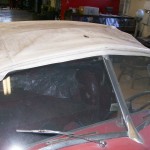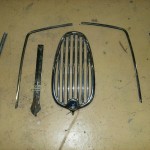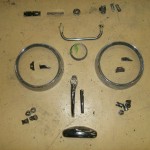1956 Jaguar XK140
This 1956 Jaguar XK140 needed a little love before it would turn any heads. We stripped down and repainted the body and built an interior. Now this Jaguar will make anyone look twice.
Explore the Project Galleries
Arrival
Disassembly
Strip & Metal Fab
Body & Paint
Finish
The great Jaguar story started in 1922 when 21-year-old Billy Lyons formed a company in partnership with a neighbour to produce motor cycle sidecars in Blackpool where they lived. From the very start, Lyons knew the importance of style. Until then they had been rather ugly appendages but the Swallow sidecars, as they were known, were very striking and attracted a lot of interest and healthy sales.
Lyons then turned his attention to cars, offering stylish bodies on popular chassis. The first and best known of these was the little Austin 7 Swallow, in open and saloon versions. Again the style caught the eye, and they proved very popular. With the introduction of the S.S. Models in 1931, Lyons evolved his thriving company a step further by arranging for the Standard Motor Company to produce engines and chassis of SS design for the company to fit long, low rakish bodies which suggested great performance but did not quite live up to that promise.
In 1935 the name Jaguar was adopted and the improved range were then known as SS Jaguars. The first real sports car, the SS100, had stunning good looks and performance to match.
The XK 120, with the new XK engine, stole the 1948 Motor Show. Lyons had designed a sensationally beautiful and ultra modern open two-seater body. With the powerful engine, the 120 promised racing car performance on the road, yet with practicality and comfort. The orders flowed in and the XK 120 led Britain’s crucial post-war export drive, being especially popular in Hollywood. Around 60% were exported to the USA, earning vital dollars to rebuild war-torn Britain.
The new large saloon appeared in 1950 and was christened the Mark VII. It was to be another great success. Meanwhile, the XK was making a tremendous name for itself on the world’s race tracks and provided an important breakthrough for a young man called Stirling Moss. XKs also distinguished themselves in rallying and record-breaking, proving the car was far more than a very pretty face. The Roadster was joined by the Fixed Head Coupé and Drop Head Coupé, before all three were succeeded in 1954 by the XK 140 range.
Read more about Jaguars at: http://www.classic-motor-cars.co.uk/about-us/history-of-jaguar/




















